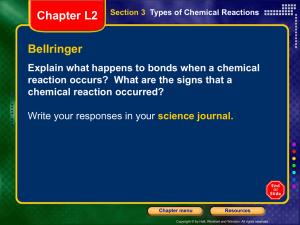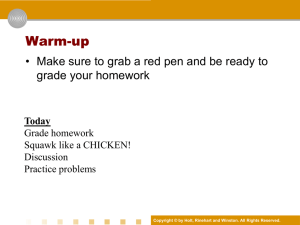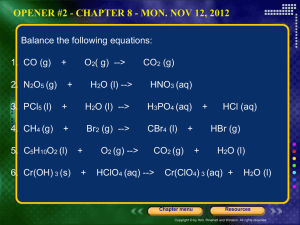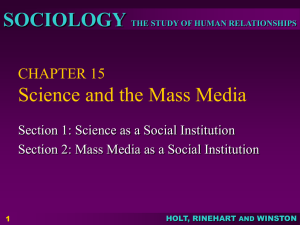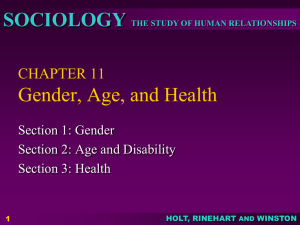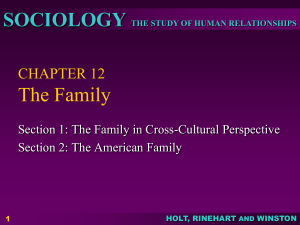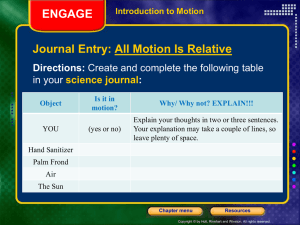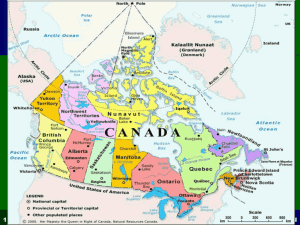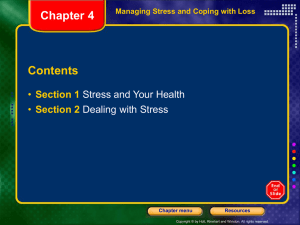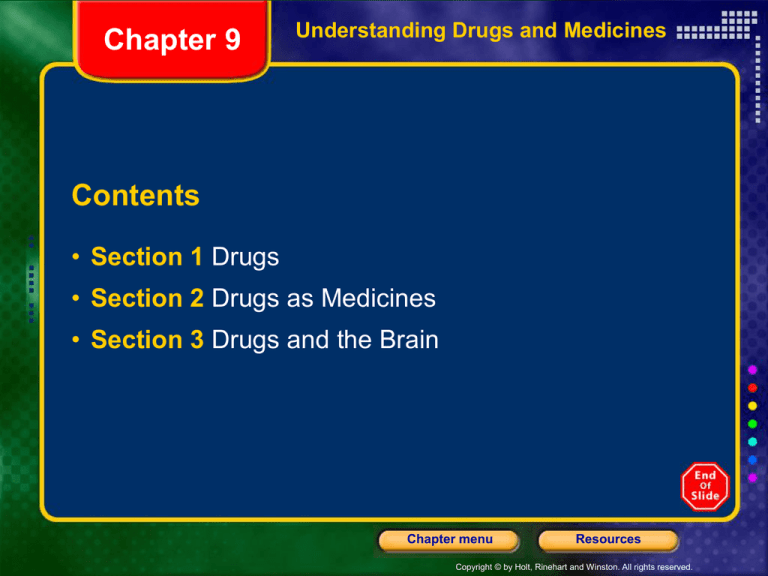
Chapter 9
Understanding Drugs and Medicines
Contents
• Section 1 Drugs
• Section 2 Drugs as Medicines
• Section 3 Drugs and the Brain
Chapter menu
Resources
Copyright © by Holt, Rinehart and Winston. All rights reserved.
Chapter 9
Section 1 Drugs
Objectives
• List three qualities that make a drug useful as a
medicine.
• Name the two sources of all drugs.
• Identify four different types of medicines and their
effects on the body.
• Identify five different ways that drugs can enter the
body.
• Describe why some drugs are considered drugs of
abuse.
Chapter menu
Resources
Copyright © by Holt, Rinehart and Winston. All rights reserved.
Chapter 9
Section 1 Drugs
Bellringer
• Name four medicines that you have heard of. What is
each of these medicines used for?
Chapter menu
Resources
Copyright © by Holt, Rinehart and Winston. All rights reserved.
Chapter 9
Section 1 Drugs
What Are Drugs?
• A drug is any substance that causes a change in a
person’s physical or psychological state.
• Medicines are drugs used to cure, prevent, or treat
illness or discomfort.
• Good medicines have the following qualities:
• Effectiveness
• Safety
• Minor side effects
Chapter menu
Resources
Copyright © by Holt, Rinehart and Winston. All rights reserved.
Chapter 9
Section 1 Drugs
What Are Drugs?
• Drugs of abuse are drugs that people take for mindaltering effects that have no medical purpose.
• Drugs of abuse can change the way your brain works
in ways that are unhealthy and dangerous.
• Drugs that affect your brain can change your
behavior over time and lead to addiction and longterm health problems.
Chapter menu
Resources
Copyright © by Holt, Rinehart and Winston. All rights reserved.
Chapter 9
Section 1 Drugs
What Are Drugs?
• All drugs are chemicals that come from one of two
sources:
• Naturals sources, such as plants, animals, or
fungi
• Laboratories
Chapter menu
Resources
Copyright © by Holt, Rinehart and Winston. All rights reserved.
Chapter 9
Section 1 Drugs
Types of Medicines
• A prescription is a written order from a doctor for a
specific medicine.
• Over-the-counter (OTC) medicines can be bought
without a prescription.
Chapter menu
Resources
Copyright © by Holt, Rinehart and Winston. All rights reserved.
Chapter 9
Section 1 Drugs
Types of Medicines
• Drugs can be taken into
the body in the following
ways:
• Implanted pumps
• Inhalation
• Injection
• Transdermal patches
• Ingestion
• Topical application
Chapter menu
Resources
Copyright © by Holt, Rinehart and Winston. All rights reserved.
Chapter 9
Section 1 Drugs
Chapter menu
Resources
Copyright © by Holt, Rinehart and Winston. All rights reserved.
Chapter 9
Section 1 Drugs
Chapter menu
Resources
Copyright © by Holt, Rinehart and Winston. All rights reserved.
Chapter 9
Section 2 Drugs as Medicines
Bellringer
• What are some reasons you think prescription and
OTC medications have instructions and precautions
written on their packaging?
Chapter menu
Resources
Copyright © by Holt, Rinehart and Winston. All rights reserved.
Chapter 9
Section 2 Drugs as Medicines
Approving Drugs for Medical Use
• The Food and Drug Administration (FDA) was
created in 1906 to control the safety of food, drugs,
and cosmetics in the United States.
• The FDA uses an approval process for proving a
drug is safe and effective. Some steps include:
•
•
•
•
Chemical or cell-culture testing in laboratories
Testing on animals
Testing on human volunteers
Clinical trials to compare to existing drugs
Chapter menu
Resources
Copyright © by Holt, Rinehart and Winston. All rights reserved.
Chapter 9
Section 2 Drugs as Medicines
Prescription Medicines
• Prescription medications should only be taken with a
doctor’s recommendation and supervision.
• Taking someone else’s medication or failing to follow
the prescription can be dangerous.
Chapter menu
Resources
Copyright © by Holt, Rinehart and Winston. All rights reserved.
Chapter 9
Section 2 Drugs as Medicines
Prescription Medicines
• Prescriptions include the following information:
•
•
•
•
Dosage (how much you should take)
When you should take the medicine
How often you should take the medicine
The length of time you should take the
medicine
Chapter menu
Resources
Copyright © by Holt, Rinehart and Winston. All rights reserved.
Chapter 9
Section 2 Drugs as Medicines
Over-the-Counter (OTC) Medicines
• Long-term use of OTC medicines can cover up more
serious problems.
• If symptoms persist, consult a doctor.
• Herbal remedies and dietary supplements do not
have to be approved by the FDA.
• Because they may have not been thoroughly tested,
herbal remedies and dietary supplements may not be
safe or effective.
Chapter menu
Resources
Copyright © by Holt, Rinehart and Winston. All rights reserved.
Chapter 9
Section 2 Drugs as Medicines
Possible Problems with Medicines
• Allergic reactions are the most serious risks to
taking medicines.
• Symptoms of anaphylactic shock include:
•
•
•
•
•
Itching all over the body
Swelling, especially in the mouth or throat
Wheezing or difficulty breathing
A pounding heart
Fainting and unconsciousness
Chapter menu
Resources
Copyright © by Holt, Rinehart and Winston. All rights reserved.
Chapter 9
Section 2 Drugs as Medicines
Possible Problems with Medicines
• Side effects are more common problems than
medicine allergies. Upset stomach, headaches, dry mouth, jittery,
sleepy
• Drug interactions occur when a drug reacts with
another drug, food, or dietary supplement to increase
or decrease the effect of one of the substances.
• Labels on OTC packages or drug information sheets
describe possible drug interactions and may also list
potential side effects.
Chapter menu
Resources
Copyright © by Holt, Rinehart and Winston. All rights reserved.
Chapter 9
Section 2 Drugs as Medicines
Using Medicines Wisely
1.
2.
3.
4.
5.
6.
Make yourself part of your own healthcare team.
Be prepared to ask questions.
Learn the facts about any medicine you take.
Listen to your body.
It’s not always safe to suddenly stop taking a drug.
Speak up and enlist your parents’ help.
Chapter menu
Resources
Copyright © by Holt, Rinehart and Winston. All rights reserved.
Drug Use, Misuse, and Abuse
Drug Use
Taking a Drug correctly for
a legitimate medical
reason.
Examples:
•Taking recommended
amount of Tylenol for pain
relief
•Taking a prescribed
medication following doctor’s
orders
Drug Misuse
Taking a legal drug
inappropriately
Examples:
•Taking a sedative to relax
before a date or important
event
•Using laxative to lose weight
•Taking a caffeine pill to stay
up and study
Drug Abuse
Taking a legal drug in such a
manner that some aspect of
the user’s life is damaged.
Taking any illegal drug, for
any purpose.
Examples:
•Underage drinking
•Smoking marijuana at any age
•Using steroids
•Taking a friend or family
member’s prescription drug for
any purpose
•Drinking 1-2 cups of coffee a
day
Chapter menu
Resources
Copyright © by Holt, Rinehart and Winston. All rights reserved.
Chapter 9
Section 3 Drugs and the Brain
Bellringer
• Write a response to the following statement: “If I want
to use drugs, it’s my choice and it doesn’t affect
anybody else beside me.”
Chapter menu
Resources
Copyright © by Holt, Rinehart and Winston. All rights reserved.
Chapter 9
Section 3 Drugs and the Brain
How Drugs That Affect the Brain Work
• Information processing in the brain takes place at the
connections between neurons, called synapses.
• Signals are passed across synapses by chemicals
called neurotransmitters.
• Neurotransmitters: acetylcholine, GABA, dopamine,
serotonin
Chapter menu
Resources
Copyright © by Holt, Rinehart and Winston. All rights reserved.
Chapter 9
Section 3 Drugs and the Brain
How Drugs That Affect the Brain Work
•
•
Some drugs affect the way neurons communicate
by
1. Acting like neurotransmitters
2. Blocking neurotransmitters
3. Changing the amount of neurotransmitters.
These changes can affect our moods and
emotions.
Chapter menu
Resources
Copyright © by Holt, Rinehart and Winston. All rights reserved.
Chapter 9
Section 3 Drugs and the Brain
The Path to Addiction
• Addiction is a condition in which a person can no
longer control his or her drug use.
• Most drugs of abuse activate the brain reward
system, which releases chemicals that give pleasure.
• The major neurotransmitter is dopamine.
• Pleasure alone does not cause addiction.
• People who become addicts usually start by
experimenting, then more regular use leads to a
series of changes on the path to addiction.
Chapter menu
Resources
Copyright © by Holt, Rinehart and Winston. All rights reserved.
Chapter 9
Section 3 Drugs and the Brain
The Path to Addiction
Chapter menu
Resources
Copyright © by Holt, Rinehart and Winston. All rights reserved.
• Physical versus Psychological Addiction
– Physical Dependence -The state in which the body
relies on a drug in order to function normally
(withdrawal)
– Psychological Dependence –The state in which
one is emotionally and mentally needing a drug to
function normally (mood disorders)
Chapter menu
Resources
Copyright © by Holt, Rinehart and Winston. All rights reserved.
Chapter 9
Section 3 Drugs and the Brain
Addiction is a Treatable Disease
• Drug addiction is a brain disorder, and it is treatable.
• Most communities offer a variety of treatment
programs for addiction.
• The best way to avoid addiction is to avoid drugs of
abuse altogether.
Chapter menu
Resources
Copyright © by Holt, Rinehart and Winston. All rights reserved.
End of Chapter 9 Show
Chapter menu
Resources
Copyright © by Holt, Rinehart and Winston. All rights reserved.

